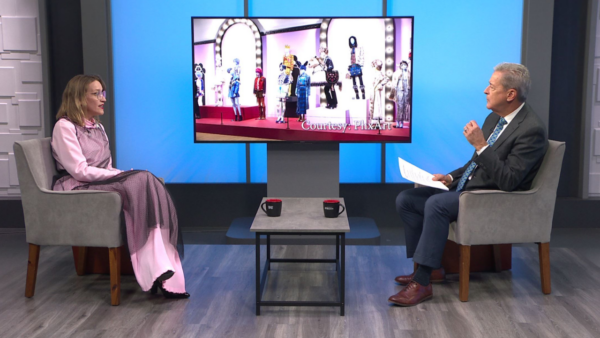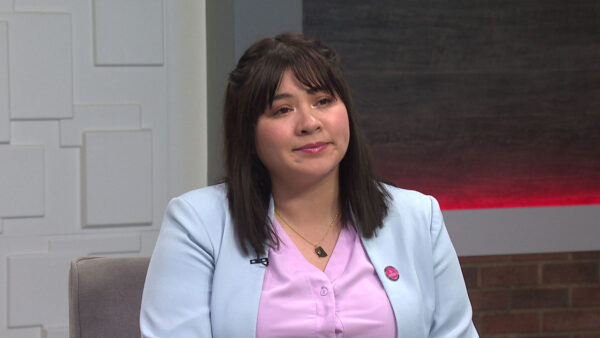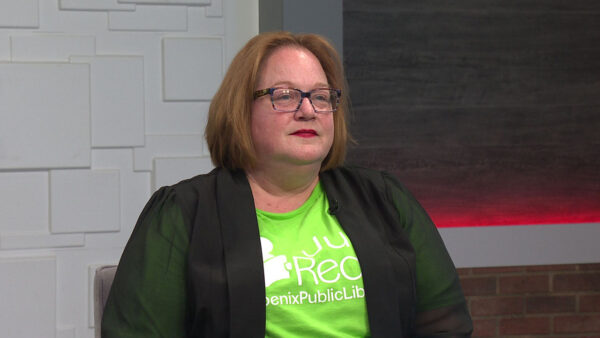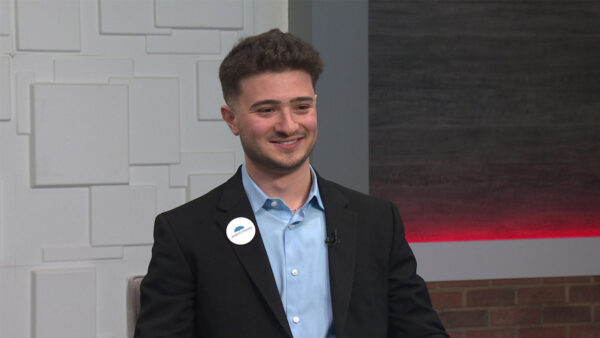Learn about Arizona’s legal and financial struggles to educate an English language learner (ELL) student. Is there a legislative solution? Discover the cost of ELL programs, and find out about models being developed to help lower costs.
Larry Lemmons:
Tonight, on this special edition of Horizon, the costs of educating more than 130,000 Arizona students who don't speak English.
Larry Lemmons:
Good evening, I'm Larry Lemmons. Horizon recently spent several evenings examining Arizona's legal and financial struggles to educate English language learners. Tonight we bring you highlights from that series: "the cost of teaching English" hosted by Steve Goldstein.
Steve Goldstein:
Although this struggle began earlier, a significant event occurred in 2000. With the passage of proposition 203, which stated ELLs should be educated in emersion programs during a temporary transition period which should be no longer than a year. This law effectively limited how kids involved in such programs should be taught. Larry Lemmons gives us this background.
Teacher:
I want you to think in your head and I want you to remember what this page is called. What is this called?
Larry Lemmons:
Laurie's first grade class looks like any other class in this elementary school. This class is a structured English immersion class. English isn't the first language for these students. Observing the class, however, it wouldn't be obvious. There are currently over 100,000 students enrolled in English language learner programs in Arizona.
Mickey Gutierrez:
We just closed off fiscal year 07 it's hovering about 139,600.
Larry Lemmons:
Mickey Gutierrez with the Arizona department of education is opening this training session for those that will be administering the English language learner assessment or azalea. The AZELA measures English language proficiency for students. Students take the AZELA after filling out the primary home language other than English home language survey or float.
Mickey Gutierrez:
The kids come in, if they put something other than English on the home language survey, then that triggers the school to test the child with the AZELA. The child takes the AZELA test and if the kid scores pre-immersion or immersion or basic or intermediate on the AZELA, then they're placed into an English learner program with parental consent.
Larry Lemmons:
The structured English immersion class is the norm today, but it wasn't always so.
Jeff Macswan:
Starting back in the '90's, we had a variety of program options available. English as a second language. 70% of kids were in that model. Bilingual education was another model. There was a variety of bilingual education called the bilingual maintenance model. 30% of kids were in that bilingual program. That the primary way or the diversity of ways in which kids were taught prior to prop 203.
Larry Lemmons:
That initiative replaced bilingual education in Arizona schools with structured English immersion. Margaret Garcia-Dugan is currently the deputy's superintendent of public instruction. She was the principal at Glendale high school while promoting proposition 203. She says bilingual education was not serving the students adequately.
Margaret Garcia-Dugan:
What we were receiving in the '80's and '90's were students that come to us from the feeder elementary that had been in this country all of their elementary years or half of their elementary school years and they weren't proficient in English.
Jeff Macswan:
I have heard these stories but they're not documented of kids that start out in elementary school and by the time they're in high school, they don't know English. I find that very difficult to believe. I've asked for documentation for that. It's not been presented.
Larry Lemmons:
The current superintendent, tom horn, ran on a platform he would enforce proposition 203 which passed by 63% of Arizona voters in 2000. Arizona has ranked near the bottom of all states in first student spending for several years. The Flores lawsuit in 1992 which to this day hasn't been settled claimed the civil rights of limited English proficient students had been violated because the state didn't adequately fund language programs. Clearly, there's disagreement as to whether or not there is sufficient money to pay for E.L.L. programs.
Margaret Garcia-Dugan:
All districts that have English language learners for the most part are what we call title one schools. They all have title one students which a lot of our E.L.L. students because of the very nature they can't speak, read and write English identifies them as a title one student by the federal government and we do receive money for those students in title one from the federal government as well as an entitlement also called title three for English language learners. So, do we have enough money? That's the big question. I believe if the money was just earmarked exactly for the classroom, all the way of the funds that we receive $355 and if we utilize the federal money as well to supplement, you should have enough money.
Larry Lemmons:
There's also disagreement to this day as to the effectiveness of bilingual education compared to the structured English immersion in effect today in most schools.
Jeff Macswan:
I did a study with colleagues looking into this. We had access to the state's language proficiency testing data. We were able to look at how kids did from one year to the next. We were interested in seeing for those kids who scored non-proficient at one point in time, a year later, we asked, how many of those kids became proficient? If s.c.i. is effective, it should be a high number. If s.c.i. is not effective, it'll be a low number. In fact it was 11%. 11% of those kids became efficient. We don't know because we don't have the data what the numbers looked like a year later, but you're clearly in a situation where kids, many, many kids, are going for years and years in an educational environment where they can't understand what's going on because for political reasons, the superintendent and others severely limit their access to instruction in their home language.
Larry Lemmons:
despite controversies, structured English immersion is the law of Arizona. This first grade class appears to reflect the success of that program.
Margaret Garcia-Dugan:
Most of our students that come into Arizona as an English language learner, 61% are k-3. If we're able to get those kids at an early age and teach them English, because their minds are like little sponges, they'll pick up English really quickly, there's no reason those kids shouldn't acquire enough English to be mainstreamed. I would think no more than a year and, ok, I'll give it maybe two years for some, but it shouldn't be the five to seven years that we were accustomed to seeing.
Larry Lemmons:
Proponents of bilingualism say it still should be available if enough wavers of structured English immersion is signed by parents.
Jeff Macswan:
By law, we could have and should have much more access to bilingual education. I would like to see a system where not just language minority kids have access to bilingualism but all kids have access to bilingualism.
Steve Goldstein:
Fifteen years ago Miriam Flores from Nogales sued the state for failing to help her daughter learn. Marcos Najera spoke with Ms. Flores in Nogales.
Marcos Najera:
Nogales, Arizona hat always been a town of two languages with people living in a region separating two countries. Many have roots in both, just like Miriam Flores and when it comes to education, she says it gets frustrating helping lawmakers think clearly about the role language plays in learning.
Miriam Florez: [speaking Spanish]
I don't know what I could say that would make them understand.
Marcos Najera:
in 1992 Miriam Flores sued the state for failing to properly educate her daughter who was a student in the Nogales Unified School District at the time. 15 years later, the Flores versus Arizona case still struggles to find resolution in the courts. But Ms. Flores' daughter who is also named Miriam is in college now at the U of A.
Miriam Flores: [speaking Spanish]
The road has been very difficult and hard. It's been difficult. I think it is twice as difficult when you are Latino facing language problems.
Marcos Najera:
When Miriam's daughter first entered school she remembers everything being just fine. The daughter's first language was Spanish and school was offering classes that catered to native speakers.
Miriam Flores: [speaking Spanish]
When she was little and in kindergarten they taught her to read in Spanish. She learned her multiplication math tables in Spanish too. And even now my daughter says that when she does her math in her head, she still multiplies in Spanish in her head.
Marcos Najera:
But the easy road didn't last long.
Miriam Flores: [speaking Spanish]
Then in first, second and third grade, that's when the problems started. Because in those first few years she started having helpers in class. Spanish speakers The school divided the children. Students who spoke English at home, had classes in English. Spanish speaking students had classes in Spanish. When she started third grade, all her classes were in English. That's when her teacher told me my daughter talked a lot with her friends during class. This seemed strange to me because Miriam was always shy and serious. I said to Miriam, ‘ You would pay money to not have to talk!' She never talked.
Marcos Najera:
Mrs. Flores didn't know what was happening. Her daughter insisted she wasn't misbehaving.
Miriam Flores: [speaking Spanish]
What the teacher thought was chatting, was Miriam asking her friends about what was happening in class. One other detail, that I forgot to mention was about the Spanish books used in class. They were from Spain.
Marcos Najera:
Even the textbooks confused her daughter. So she asked her mom for help.
Miriam Flores: [speaking Spanish]
She asked me what the words meant. I didn't know. I couldn't even help. We looked in encyclopedias for answers.
Marcos Najera:
Even with the confusion of the books, the language and curriculum, the family refused to give up. Despite the daily classroom schedule that Miriam's daughter faced.
Miriam Flores: [speaking Spanish]
Little by little with a lot of work.. I watched her closely because she's persistent. She was always studying. I'd have to tell her to go to bed when it got too late. She would seem hypnotized by the computer. I'd tell her not to overdo it. I would remind her she had school the next day and she'd have to wake up early. But there she'd stay. That's why sometimes I think it's twice as difficult for us. She tells me that even in college now, she has to look up some words to find meaning.
Marcos Najera:
Nonetheless, Mrs. Flores is proud of her daughter, who is now an advanced nursing student at the U of A. Even though the controversy continues over the learning of one language, English, Mrs. Flores daughter through the university studies now speaks four.
Miriam Flores: [speaking Spanish]
When parents get involved in their child's school, kids know they're important. And children learn school is important. An they have to reach higher.
Steve Goldstein: Tim Hogan is the executive director of the center for law in the public interest and the attorney for the plaintiffs challenging the adequacy of state funding for English language learning programs. The defendants in the case are the state of Arizona state legislature and the state superintendent of public instruction, Tom Horne. Earlier we spoke with both Tim Hogan and Tom Horne about the lawsuit.
Tim Hogan:
In the Flores case, we claimed that the case had not taken appropriate action to help these kids overcome their language barriers because they failed to adequately fund programs for English language learners. And that in fact the funding for those programs was not only inadequate but also arbitrary. It wasn't based on anything. It was just a number that legislature had picked out and decided that they were willing to fund. And we alleged that is a violation of the equal education opportunities act.
Tom Horne:
The important findings were made in the year 2000 where the center for law in the public interest chose the Nogales school district. I think they thought that was the worst performing district. So they chose that as that as the plaintiff's class and the findings made in 2000 about all the bad thing that were happening there, the kid were not doing well, the buildings were dilapidated the teachers didn't have proper tragedy and so on.
Tim Hogan:
The base level funding which represents an average amount needed to educate students generally at that time was somewhere around maybe $2,500 per student. The courts said that extra 150 that the legislature was funding was inadequate and caused deficiencies in the Nogales Unified School District, which is representative of the state in this lawsuit. This lawsuit applies statewide despite the state's claims to the contrary. That the 150 was inadequate because it had resulted in crowded classrooms, not enough teachers not enough materials and on and on. And also just plain arbitrary, that legislature had taken the $450 that they knew some school districts were spending and just kind of arbitrarily decided they were only going to fund a third of that. And the court said that you have to fund these programs based on the cost of providing the programs in order for it to be a rational, non-arbitrary funding system.
Tom Horne:
It's not only a matter of funding but it's a matter that the funding was used correctly. We have to be sure that funds were used properly so we get good results.
Tim Hogan:
each time that the legislature is confronted with data about what it costs they're going to -- they're basically going to ignore it and talk about other things. This has never been about news this case trying to tell the legislature how kid should be educated. That's a policy decision up to the legislature. But the law requires that they fund it.
Tom Horne:
The funding now is over double what it was for English language learners. We spend about 6,000 per pupil in Arizona through English language learners get an extra $350 per student that other kids don't get. And in 2000 it was 100 and some dollars. It's more than doubled. And a lot of the other funding increased substantially. And now we have No Child Left Behind with efforts by the federal government. So the situation is very different now than it was then, between 2000 and 2005, we had an excellent superintendent his name is Kelp Cooper, and he headed up our technical assistance program for schools. In 2000 and 2005 he turned around that district. So that the test scores that the kids -- went up. They emphasized academics. They eliminated social promotion. If the kid weren't learning they wouldn't go up the next grade level, which meant they had to have an intervention in the summertime because the parents wanted them to go to the next grade level. So the kids did much better.
Tim Hogan:
no question there's been improvement in Nogales. And the way Nogales has done that is by taking money away from other programs, taking federal funds, taking money generated off the local tax base. Because the problem for school districts is it is a federal law, the school district has an obligation as well. So they have to find the money to take care of the problem and try and provide adequate programs.
Tom Horne:
Some of it is federal funds. Some of its different kinds of state funds, some of it is local funds. One of the differences with Tim Hogan is he thinks that federal law requires that all the additional funding come out of the -- all the federal government requires is that you have the stems to have the kid learn English and be able to compete academically. That funding is being provided. I don't think the whole burden should be put on the Arizona taxpayer. I think one of the ironies that the judge came up with that it's part of that ideal. Even the money that federal government does provide in -- for English language learners. He says if you found a different number that we were spending would be the appropriate number, we can't count the federal money. The Arizona tax payer has to bear the full burden, even though the great majority of the students are here because of the federal government not guarding our border.
Tim Hogan:
That's not the issue. The issue is these kids are here. I always say, you let me know when they're gone and we'll do something different. And by the way, almost all these kids are United States citizens. This is just not a -- people tend to confuse some of these issues. But i say, while they're here let's treat them the same way we treat all the kids and have the same goals for these kids that we have for all our kids in public school, which is to get a quality education and be all you can be.
Steve Goldstein:
the state of Arizona is required to provide kids with a public education. That includes about 135,000 students who are classified as English learners. But a federal judge has ruled on more than one occation that Arizona does nod provide adequate funding for that group of kid. As we continue our series, "the cost of teaching English David Majure shows us what law makers are doing to improve their educational opportunities.
David Majure:
the Arizona provide its schools with a base of about $6,000 per student. For each kid classified as English language learning, schools get an extra $350. The Phoenix's Murphy school district says it costs more than that to educate E.L.L. students.
Teacher:
it costs about $1,900 per E.L.L. student.
David Majure: since 2001, Arizona has been under federal court order to fulfill its legal obligation to educate English learners by providing adequate funding. But the legislative leaders and the courts cannot agree on what is adequate.
Linda Lopez:
I think that response by leadership to the lawsuit is being driven by those concerned. The problem is, the immigrants are not the entire problem. It's not just the Mexican kids or kids from Central America kids here as English language learners. We have kids from all over the world. Tucson, for example, has refugee resettlement community. We have kids coming in from Somalia who don't even know how to turn on a light switch, let alone have ever seen a book. These kinds of things are pervasive across the system. Not just undocumented kids that are -- undocumented kids that are driving the issue.
John Huppenthal:
we don't want to make any assumptions these are immigrants. We should be focused on providing good schools and good education for them.
Linda Lopez:
these kids will grow up, live in this state. Don't we want them to be earning the most amount of money they can so they can participate as tax-paying citizens in this state? That's what's really important.
John Huppenthal:
it's in our cultural d.n.a. Thomas Jefferson put it right in there that we need to be concerned about the most disadvantaged. These kids that can't speak the language, it impacts them the most. We should care.
Linda Lopez:
One of the things we are seeing are the kids who are E.L.L., they're the ones who are having the most struggles in terms of meeting the requirements of the aims standards. They drop out. It takes longer for them to graduate. They need extra -- in order to meet the standards. When we had the reports of the kids that weren't meeting the aims standards, they were almost all of them English language learners. And we had to expend extra dollars in order to help them meet those standards. We weren't getting reimbursed for that. We had to get that money from other parts of the budget in order to do that.
David Majure:
that's how the Murphy school district comes up with the money it needs to educate English learners.
Linda Lopez:
you're robbing those children who are not the English learners, taking that away from them and directing them to English language learners.
David Majure:
the state legislature's most recent attempt to fix the problem is house bill 2064. In today's dollars it would increase state per pupil funding for E.L.L. kids from 350 to about $425. But only if the court signs off on the plan which has not happened.
Councilmember:
there are two items on the agenda.
David Majure:
the bill also established the English language learners task force to develop models of structured English immersion for use by schools. The task force must also come up with procedures for determining the cost of implementing the models. After a school selects its model it must use it's per pupil state E.L.L. funds and a variety of federal dollars to pay for it. If that doesn't cover the cost of implementing the model the school can apply for additional money from a new structured English immersion fund. But S.E.I. funds are available to the same student for only two years. Students who take long than that to reach English proficiency may qualify for compensatory funds which can be used for tutoring and services other than normal classroom instruction. Governor Napolitano allowed house bill 2064 to become law without her signature. The federal court ruled it unconstitutional, a decision that is now being appealed. And state lawmakers we spoke to didn't like the bill for a variety of reasons.
John Huppenthal:
In an ideal world, by my thoughts we wouldn't have done the house bill. The house bill is a direct response to the lawsuit, to an interference in the education system by the courts and to me an unwarranted interference.
David Majure
Republican senator John Huppenthal says more money won't necessarily lead to better outcomes for E.L.L. students. He believes they'd be better off if there was more parental choice and competition in public schools.
John Huppenthal:
we know that some schools perform better than others. If we end up with an education culture in which student are migrating towards the best schools and the other schools are stimulated by that competition to rise to that level that education culture will produce the best outcome for these kids.
David Majure:
representative Linda Lopez believes money will make a difference. She says there's been far too little for it for E.L.L. kids since the Flores lawsuit was filed in 1992.
Linda Lopez:
everything we've done was an effort to avoid dealing with the lawsuit, avoid doing what needs to be done for these kids. I'm concerned that since 1992, we've had a whole generation of students who have not been able to receive the benefits of increased support in terms of the teachers being trained, how to lower class size, increased -- books and materials, a whole generation of kids have been lost. And I think it's not just a detriment to those children but it's a detriment to the state of Arizona as well.
Larry Lemmons:
that concludes this Horizon special, "the cost of teaching English." Since our series aired, the E.L.L. task force adopted a model that schools will use to teach English learners. It requires E.L.L. students to spend four hours a day in English language development. Teachers say funding will be tied to the cost of implementing the model. The Flores v. Arizona lawsuit is still alive in the courts. Thanks for joining us. I'm Larry Lemmons. Good night.
























